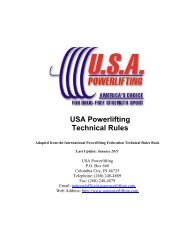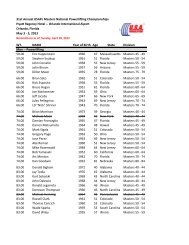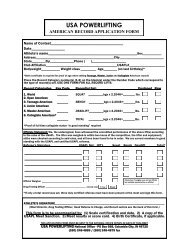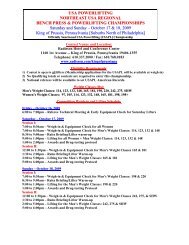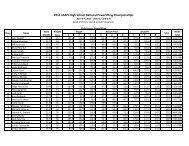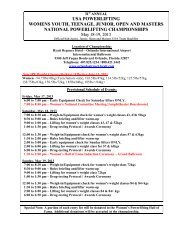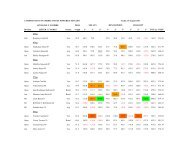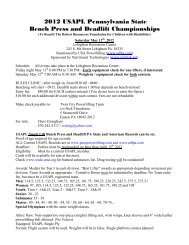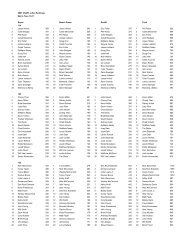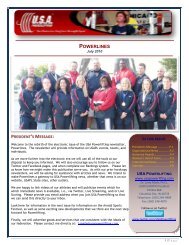Lifter's Handbook - USA Powerlifting
Lifter's Handbook - USA Powerlifting
Lifter's Handbook - USA Powerlifting
You also want an ePaper? Increase the reach of your titles
YUMPU automatically turns print PDFs into web optimized ePapers that Google loves.
Squat<br />
1. The lifter shall face the front of the platform. The bar shall be held horizontally across the shoulders, hands and fingers<br />
gripping the bar, and the top of the bar not more than the thickness of the bar below the outer edge of the shoulders. The<br />
diagram, on page 7, indicates the legal position of the bar across the shoulders. The hands may be positioned anywhere on<br />
the bar inside and/ or in contact with the inner collars.<br />
2. After removing the bar from the racks, (the lifter may be aided in removal of the bar from the racks by the spotter/loaders) the<br />
lifter must move backwards to establish the starting position. When the lifter is motionless, erect with knees locked, and the<br />
bar properly positioned, the Chief Referee will give the signal to begin the lift. The signal shall consist of a downward<br />
movement of the arm and the audible command “Squat”. Before receiving the signal to “Squat” the lifter may make any<br />
position adjustments within the rules, without penalty. For reasons of safety the lifter will be requested to “Replace” the bar,<br />
together with a backward movement of the arm, if after a period of five seconds he is not in the correct position to begin the<br />
lift. The Chief Referee will then convey the reason why the signal was not given.<br />
3. Upon receiving the Chief Referee’s signal the lifter must bend the knees and lower the body until the top surface of the legs<br />
at the hip joint is lower than the top of the knees. Only one decent attempt is allowed. The attempt is deemed to have<br />
commenced when the lifters knees have unlocked. The bar may move from its starting position downwards on the lifters<br />
back the thickness/diameter of the bar during the performance of the lift.<br />
4. The lifter must recover at will to an upright position with the knees locked. Double bouncing at the bottom of the squat<br />
attempt or any downward movement is not permitted. When the lifter is motionless (in the apparent final position) the Chief<br />
Referee will give the signal to rack the bar.<br />
5. The signal to rack the bar will consist of a backward motion of the arm and the audible command “Rack”. The lifter must<br />
then move forward and return the bar to the racks. For reasons of safety the lifter may request the aid of the spotter/loaders in<br />
returning the bar to, and replacing it in the racks. The lifter must stay with the bar during this process.<br />
6. Not more than five and not less than two spotter/loaders shall be on the platform at anytime. The Referees may decide to the<br />
number of spotter/loaders required on the platform at any time 2, 3, 4, or 5.<br />
Causes for Disqualification of a Squat<br />
1. Failure to observe the Chief Referee’s signals at the commencement or completion of a lift.<br />
2. Double bouncing at the bottom of the lift, or any downward movement during the ascent.<br />
3. Failure to assume an upright position with the knees locked at the commsencement or completion of the lift.<br />
4. Stepping backward or forward although lateral movement of the sole and rocking the feet between the ball and heel is<br />
permitted.<br />
5. Failure to bend the knees and lower the body until the top surface of the legs at the hip joint is lower than the top of the<br />
knees, as in the diagram.<br />
6. Any movement of the bar on the back more than the diameter/thickness of the bar below its starting position.<br />
7. Contact with the bar or the lifter by the spotter/loaders between the Chief Referee’s signals in order to make the lift<br />
easier.<br />
8. Contact of the elbows or upper arms with the legs. Slight contact is permitted if there is no supporting that might aid<br />
the lifter.<br />
9. Any dropping or dumping of the bar after completion of the lift.<br />
10. Failure to comply with any of the items outlined under Rules of Performance for the squat.<br />
The diagrams below indicate the legal bar position and required depth in the squat:





